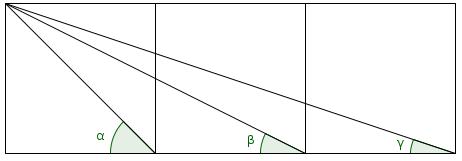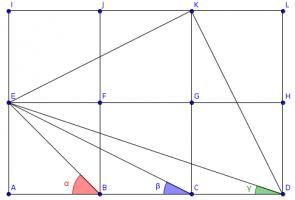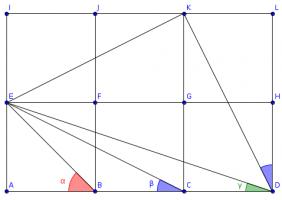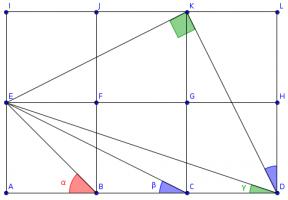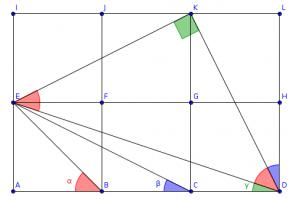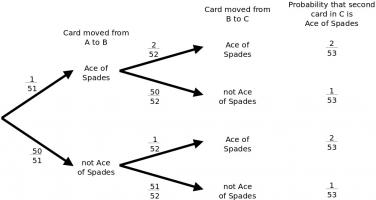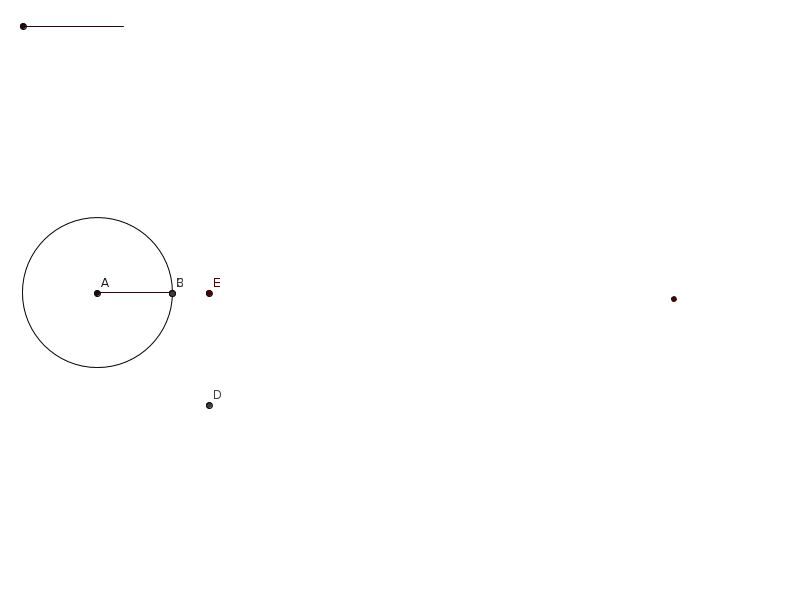Puzzles
Double derivative
What is
$$\frac{d}{dy}\left(\frac{dy}{dx}\right)$$
when:
(i) \(y=x\)
(ii) \(y=x^2\)
(iii) \(y=x^3\)
(iv) \(y=x^n\)
(v) \(y=e^x\)
(vi) \(y=\sin(x)\)?
Show answer & extension
Hide answer & extension
(ii) Differentiating \(y=x^2\) with respect to \(x\) \(\frac{dy}{dx}=2x\). Let \(g=\frac{dy}{dx}\). By the chain rule:
$$\frac{dg}{dy}=\frac{dg}{dx}\frac{dx}{dy}$$
$$=2\frac{1}{2x}$$
$$=\frac{1}{x}$$
So \(\frac{d}{dy}\left(\frac{dy}{dx}\right)=\frac{1}{x}\)
(iii) By the same method, \(\frac{d}{dy}\left(\frac{dy}{dx}\right)=\frac{2}{x}\)
(iv) \(\frac{d}{dy}\left(\frac{dy}{dx}\right)=\frac{n-1}{x}\)
(v) \(\frac{d}{dy}\left(\frac{dy}{dx}\right)=1\)
(vi) \(\frac{d}{dy}\left(\frac{dy}{dx}\right)=-\tan(x)\)
Extension
What is
$$\frac{d}{dy}\left(\frac{dy}{dx}\right)$$
when \(y=f(x)\)?
Equal opportunity
Can two (six-sided) dice be weighted so that the probability of each of the numbers 2, 3, ..., 12 is the same?
Show answer & extension
Hide answer & extension
Let \(p_1\), \(p_2\), ..., \(p_6\) be the probabilities of getting 1 to 6 on one die and \(q_1\), ..., \(q_6\) on the other. The probability of getting a total of 2 is \(p_1q_1\) and the probabilty of getting a total of 12 is \(p_6q_6\). Therefore \(p_1q_1=p_6q_6\).
If \(p_1\geq p_6\) then \(q_1\leq q_6\) (and vice-versa) as otherwise the above equality could not hole. Therefore:
$$(p_1-p_6)(q_1-q_6)\leq 0$$
$$p_1q_1-p_6q_1-p_1q_6+p_6q_6\leq 0$$
$$p_1q_1+q_6p_6\leq p_1q_6+p_6q_1$$
The probability of rolling a total of 7 is \(p_1q_6+p_2q_5+...+p_6q_1\). This is larger than \(p_1q_6+p_6q_1\), which is larger than (or equal to) \(p_1q_1+q_6p_6\), which is larger than \(p_1q_1\).
Therefore the probability of rolling a 7 is larger than the probability of rolling a two, so it is not possible.
Extension
Can two \(n\)-sided dice be weighted so that the probability of each of the numbers 2, 3, ..., 2\(n\) is the same?
Can a \(n\)-sided die and a \(m\)-sided die be weighted so that the probability of each of the numbers 2, 3, ..., \(n+m\) is the same?
Three squares
The diagram shows three squares with diagonals drawn on and three angles labelled.
What is the value of \(\alpha+\beta+\gamma\)?
Show answer & extension
Hide answer & extension
Draw three more squares and add these lines (I have coloured the angles to make equal angles clearer):
Triangles \(ACE\), \(LDK\) and \(IKE\) are congruent, so angle \(KDL\) is equal to \(\beta\).
The congruence of these triangles tells us that angles \(DKL\) and \(EKI\) add up to a right angle, so angle \(EKD\) is also a right angle.
The congruence of the triangles also tells us that \(KD\) and \(KE\) are the same length and so angle \(EDK\) is the angle in an isosceles right-angled triangle. \(\alpha\) is also the angle in an isosceles right-angled triangle, so these two angles are equal.
Therefore \(\alpha+\beta+\gamma=90^\circ\).
Extension
The diagram shows three rhombuses with diagonals drawn on and three angles labelled.
What is the value of \(\alpha+\beta+\gamma\)?
The ace of spades
I have three packs of playing cards with identical backs. Call the packs A, B and C.
I draw a random card from pack A and shuffle it into pack B.
I now turn up the top card of pack A, revealing the Queen of Hearts.
Next, I draw a card at random from pack B and shuffle it into pack C. Then, I turn up the top card of pack B, revealing another Queen of Hearts.
I now draw a random card from pack C and place it at the bottom of pack A.
What is the probability that the card at the top of pack C is the Ace of Spades?
Show answer
Hide answer
The problem can be expressed using the following probability tree:
The probability that the card turned over from C is an Ace of Spades is:
$$\frac{1\times 2\times 2+1\times 50\times 1+50\times 1\times 2+50\times 51\times 1}{51\times 52\times 53}$$
$$=\frac{52}{51\times 53}$$
3n+1
Let \(S=\{3n+1:n\in\mathbb{N}\}\) be the set of numbers one more than a multiple of three.
(i) Show that \(S\) is closed under multiplication.
ie. Show that if \(a,b\in S\) then \(a\times b\in S\).
Let \(p\in S\) be irreducible if \(p\not=1\) and the only factors of \(p\) in \(S\) are \(1\) and \(p\). (This is equivalent to the most commonly given definition of prime.)
(ii) Can each number in \(S\) be uniquely factorised into irreducibles?
Show answer & extension
Hide answer & extension
(i) Let \(a,b\in S\). Then \(\exists \alpha,\beta\in \mathbb{N}\) such that \(a=3\alpha+1\) and \(b=3\beta+1\).
(This says that if \(a\) and \(b\) are in \(S\) then they can be written as a multiple of three plus one.)
$$a\times b=(3\alpha+1)\times (3\beta+1)$$
$$=9\alpha\beta+3\alpha+3\beta+1$$
$$=3(3\alpha\beta+\alpha+\beta)+1$$
This is a multiple of three plus one, so \(a\times b\in S\).
(ii) No, as \(36\times 22=4\times 253\) and 36,22,4 and 253 are all irreducible.
Extension
Try the task again with \(S=\{a+b\sqrt{2}:a,b\in\mathbb{Z}\}\).
2009
2009 unit cubes are glued together to form a cuboid. A pack, containing 2009 stickers, is opened, and there are enough stickers to place 1 sticker on each exposed face of each unit cube.
How many stickers from the pack are left?
Show answer & extension
Hide answer & extension
\(2009=7\times 7\times 41\), so there are four possible sets of dimensions of the cuboid:
$$1\times 1\times 2009$$
$$1\times 7\times 287$$
$$1\times 41\times 49$$
$$7\times 7\times 41$$
In the first three cuboids, there is a face with an area of 2009 units (\(2009\times 1\), \(7\times 287\) and \(41\times 49\) respectively) and so 2009 stickers will not be enough. Therefore the cuboid has dimensions \(7\times 7\times 41\) and a surface area of 1246, leaving 763 stickers left over
Extension
For which numbers \(n\) can a cuboid be made with \(n\) unit cube such that \(n\) unit square stickers can cover the faces of the cuboid?
Sine
A sine curve can be created with five people by giving the following instructions to the five people:
A. Stand on the spot.
B. Walk around A in a circle, holding this string to keep you the same distance away.
C. Stay in line with B, staying on this line.
D. Walk in a straight line perpendicular to C's line.
E. Stay in line with C and D. E will trace the path of a sine curve as shown here:
What instructions could you give to five people to trace a cos(ine) curve?
What instructions could you give to five people to trace a tan(gent) curve?
Show answer & extension
Hide answer & extension
Cosine can be drawn the same way as sine but starting B at the top of the circle.
Tangent can be drawn by giving the following instructions:
A. Stand on the spot.
B. Walk around A in a circle, holding this string to keep you the same distance away.
C. Make a straight line with A and B, staying on the line tangent to the circle through B's starting point.
D. Walk in a straight line perpendicular to C's line.
E. Stay in line with C and D.
Could people be used to draw graphs of secant, cosecant and cotangent?
Triangles between squares
Prove that there are never more than two triangle numbers between two consecutive square numbers.
Show answer & extension
Hide answer & extension
Let \(T_a\) represent the \(a\)th triangle number. This means that \(T_a=\frac{1}{2}a(a+1)\).
Suppose that for some integer \(n\), \(n^2 \leq T_a <(n+1)^2\). This means that:
$$n^2 \leq T_a$$
$$n^2 \leq \frac{1}{2}a(a+1)$$
$$2n^2 \leq a^2+a$$
But for every positive integer \(a \leq a^2\), so:
$$2n^2 \leq 2a^2$$
$$n^2 \leq a^2$$
\(n\) and \(a\) are both positive integers, so:
$$n \leq a$$
Now consider \(T_{a+2}\):
$$T_{a+2}=\frac{1}{2}(a+2)(a+3)$$
$$=\frac{1}{2}(a^2+5a+6)$$
$$=\frac{1}{2}(a^2+a)+\frac{1}{2}(4a+6)$$
$$=\frac{1}{2}a(a+1)+2a+3$$
$$=T_a+2a+3$$
We know that \(a \geq n\) and \(T_a \geq n^2\), so:
$$T_a+2a+3 \geq n^2+2n+3$$
$$>n^2+2n+1 = (n+1)^2$$
And so \(T_{a+2}\) is not between \(n^2\) and \((n+1)^2\). So if a triangle number \(T_a\) is between \(n^2\) and \((n+1)^2\) then the next but one triangle number \(T_{a+2}\) cannot also be between \(n^2\) and \((n+1)^2\). So there cannot be more than two triangle numbers between \(n^2\) and \((n+1)^2\).
Extension
Given an integer \(n\), how many triangle numbers are there between \(n^2\) and \((n+1)^2\)?

